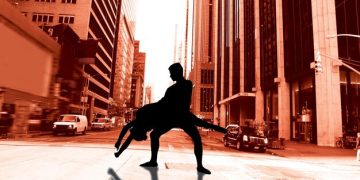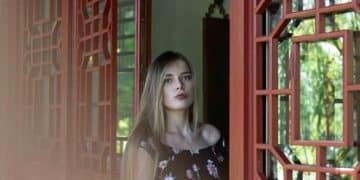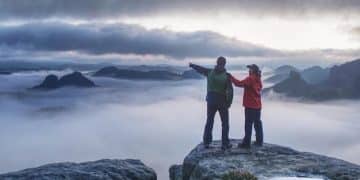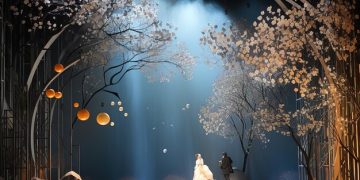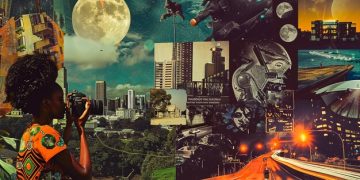K-Drama Cinematography: Visual Storytelling in 3 Award-Winning Series
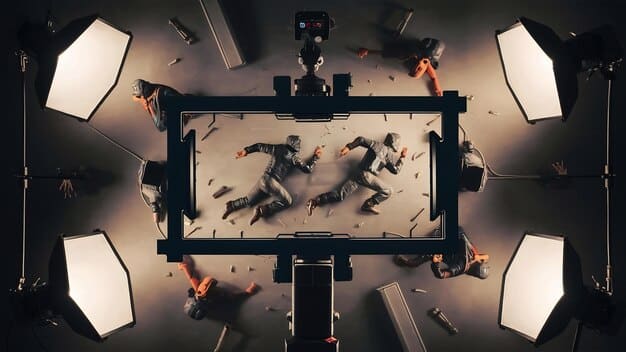
The visual artistry of K-dramas, particularly through their cinematography, elevates storytelling from mere narratives to immersive experiences, showcasing sophisticated techniques that have earned international acclaim and set new benchmarks in television production.
The world of K-dramas has captured global audiences with its compelling narratives, intricate character development, and unique cultural insights. Beyond these elements, the sophisticated visual storytelling, particularly the K-Drama cinematography, plays a crucial role in creating lasting impressions. This article delves into the visually stunning techniques employed in three award-winning series, exploring how directors and cinematographers craft memorable scenes and enhance emotional depth.
The Art of Visual Storytelling in K-Dramas
K-dramas are renowned for their highly aesthetic visual appeal, often resembling feature films rather than television series. This cinematic quality is no accident; it is the result of deliberate choices in composition, lighting, camera movement, and color grading. These elements work in harmony to build atmosphere, convey character emotions, and advance the plot in subtle yet powerful ways.
Unlike many Western productions where speed and efficiency might dictate visual choices, K-dramas often dedicate significant resources to achieving a distinct visual style. This commitment to aesthetic excellence contributes significantly to their global popularity, drawing viewers into worlds that are both fantastical and deeply real.
Composition and Framing: More Than Just a Shot
Composition in K-drama cinematography goes beyond simply placing subjects within a frame. It involves meticulous planning to ensure every element contributes to the narrative. Directors often use wide shots to establish grand settings or intricate interior designs, drawing attention to production values. Conversely, tight close-ups on actors’ faces capture the nuanced emotional shifts that are hallmarks of K-drama performances. The use of negative space, leading lines, and the rule of thirds are common techniques that guide the viewer’s eye and enhance visual balance.
- Symmetrical Balance: Often used to convey order, formality, or a sense of harmony.
- Asymmetrical Balance: Creates dynamic tension and visual interest, often reflecting internal conflict.
- Deep Staging: Arranging elements at varying distances from the camera to create depth and immersion.
- Framing Devices: Using natural or artificial elements to frame characters, emphasizing their isolation or connection.
The careful consideration of these compositional elements allows K-dramas to communicate complex ideas and emotions without relying solely on dialogue, creating a visual language that is universally understood.
Furthermore, the deliberate use of reflections, particularly through mirrors or glass surfaces, adds layers to the visual narrative. These reflections can symbolize a character’s dual nature, their internal struggles, or even foreshadow future events. This nuanced approach to framing turns every scene into a piece of art, engaging the viewer on multiple sensory levels.
Lighting and Color Theory: Setting the Mood
Lighting and color are perhaps two of the most potent tools in the K-drama cinematographer’s arsenal. They are not merely functional but serve as crucial storytelling devices, dictating the mood, atmosphere, and even the psychological state of characters. The intentional manipulation of light and shadow, combined with a sophisticated color palette, transforms ordinary scenes into emotionally charged moments.
For instance, warm, golden hour lighting is frequently employed to evoke romance and nostalgia, while stark, cool tones can signify danger, sadness, or a harsh reality. The careful balance between natural and artificial light sources ensures that characters are always presented in a way that accentuates their expressions and movements.
The Psychology of Color Grading
Color grading in K-dramas is an extensive post-production process that significantly impacts the final look and feel of a series. Each drama often has a unique color scheme that permeates its entire run, acting as a visual signature. This can range from vibrant, saturated colors for whimsical and youthful narratives to muted, desaturated tones for more somber and reflective stories.
- Warm Colors (Reds, Oranges, Yellows): Connote passion, energy, happiness, or danger.
- Cool Colors (Blues, Greens, Purples): Represent calm, mystery, sadness, or sophistication.
- Monochromatic Palettes: Often used to convey uniformity, constraint, or a particular mood of melancholy.
- Desaturated Tones: Can make a scene feel more realistic, gritty, or historically set, enhancing a sense of nostalgia.
The strategic use of color can highlight specific character arcs or thematic developments. A character’s world might begin with cool, sterile hues and slowly transition to warmer, more inviting tones as they find love or purpose, visually mirroring their internal growth.
Beyond broad strokes, the application of specific color filters and gels during filming further refines the visual language. These techniques ensure that even subtle variations in light and color contribute meaningfully to the overarching narrative, making the visual experience as rich and complex as the plot itself.
Camera Movement and Editing: Pacing the Narrative
The way the camera moves, or chooses not to move, and how shots are edited together profoundly influences the viewer’s perception of time, space, and emotion in K-dramas. Dynamic camera work can heighten tension or excitement, while static shots can emphasize contemplation or stillness. The careful rhythm of editing then ensures that these visual elements flow seamlessly, guiding the audience through the story’s emotional landscape.
Many K-dramas favor smooth, deliberate camera motions, utilizing cranes, dollies, and Steadicams to create a sense of elegance and fluidity. Panning shots often reveal expansive landscapes or intricate architectural details, embedding the characters within their environment. Tracking shots, on the other hand, can create intimacy, following characters as they navigate their world, drawing the viewer into their physical and emotional journey.
The Impact of Shot Transitions
Editing in K-dramas often employs a variety of transition techniques to connect scenes and convey narrative progression. From subtle dissolves that suggest the passage of time to sharp cuts that create a sense of urgency or surprise, each editorial choice is made with precision. The pacing of these transitions can accelerate or decelerate the emotional impact of a sequence.
- Slow Motion: Emphasizes dramatic moments, emotional breakthroughs, or significant plot points.
- Montages: Effectively condense time or illustrate a character’s development over a period.
- Jump Cuts: Employed sparingly, they can create a sense of discomfort, disorientation, or fragmented memory.
- Match Cuts: Smoothly connect two seemingly disparate scenes through visual similarity, drawing thematic parallels.
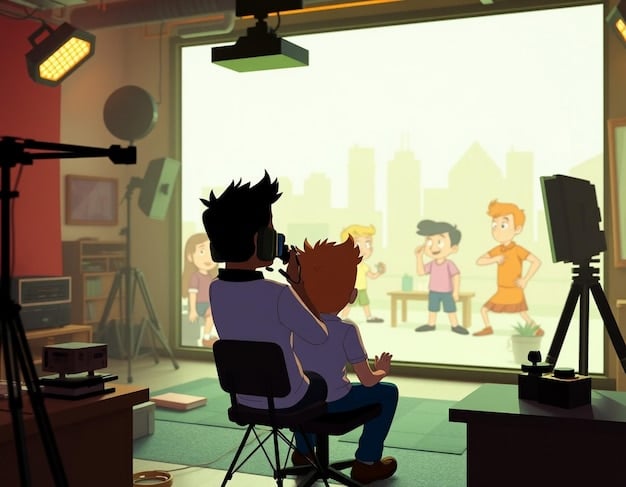
The meticulousness in planning camera movements and the artful execution of editing contribute to K-dramas’ reputation for visually compelling storytelling. Every cut, every pan, every zoom is a deliberate decision, designed to evoke a specific response from the audience, shaping their emotional connection to the characters and their plight.
Case Study 1: “Goblin” (Guardian: The Lonely and Great God)
“Goblin” is a prime example of K-drama cinematography elevating a fantastical narrative. Directed by Lee Eung-bok and shot by Park Sung-yong, the series is a masterclass in visual opulence and emotional depth. Its legendary cinematography perfectly complements the epic tale of a cursed immortal and a young woman destined to end his suffering.
The drama utilizes a rich, often melancholic color palette, with hues of deep blue, grey, and brown predominating to reflect the titular character’s ancient sorrow. However, these are often contrasted with vibrant golds and reds in moments of love or profound magical intervention, creating a visual ebb and flow that mirrors the narrative’s emotional shifts. The Canadian landscapes, specifically Quebec City, are captured with breathtaking scope, using wide shots that emphasize the grandeur and timelessness of the goblin’s existence.
Signature Visual Techniques in “Goblin”
One of “Goblin’s” most memorable techniques is its use of slow motion, particularly during pivotal, highly emotional scenes. This choice amplifies the impact of character interactions, allowing viewers to savor every nuanced facial expression and subtle gesture. The iconic “walking through the fog” scenes are beautifully rendered with soft, diffused lighting, creating an ethereal quality that underscores the supernatural elements of the story.
- Shallow Depth of Field: Often used in romantic scenes to isolate characters and emphasize intimacy.
- Strategic Lens Flares: Adds a dreamy, magical quality, especially during scenes involving supernatural powers.
- Dynamic Tracking Shots: Follows characters through bustling markets or quiet, atmospheric streets, immersing the viewer in their journey.
- Reflective Surfaces: Utilizes puddles, windows, and ornate mirrors to add visual interest and symbolic depth.
The cinematography in “Goblin” doesn’t just record the story; it participates in it. It makes emotions tangible, turns ordinary environments into magical realms, and underscores the profound themes of fate, love, and sacrifice. The show stands as a testament to how visual storytelling can enhance and deepen a complex narrative, making it an unforgettable viewing experience and a benchmark for K-drama production.
Case Study 2: “Parasite” (Film, but often referenced for K-drama’s influence)
While “Parasite” is a feature film and not a K-drama series, its groundbreaking cinematography by Hong Kyung-pyo is incredibly influential and often referenced in discussions about high-quality Korean visual storytelling, permeating TV productions. The film’s visual techniques are crucial to its thematic exploration of class disparity, societal structures, and the human condition under duress. The meticulous framing and innovative use of space are particularly noteworthy, showcasing how cinematography can be as much a character as the actors themselves.
“Parasite” uses stark visual contrasts to highlight the chasm between the wealthy Park family and the struggling Kim family. The Park’s modernist home is depicted with clean lines, open spaces, and abundant natural light, symbolizing their transparency and privilege. In contrast, the Kim’s semi-basement apartment is dark, cramped, and often shown through a yellowish, sickly filter, visually representing their oppressive circumstances and lack of social mobility.
Architectural Cinematography in “Parasite”
The film ingeniously uses architectural elements to reinforce its central themes. The staircase, for example, is not merely a means of passage but a powerful metaphor for social ascent and descent. Shots tracking characters up and down these stairs often foreshadow their changing fortunes or reveal their true intentions. The camera angles are deliberately chosen to emphasize hierarchy, with low angles making the rich appear towering and powerful, and high angles making the poor seem small and vulnerable.
- Confined Spaces: Deliberate framing to make the Kim’s home feel suffocating, contrasting with the Park’s expansive residence.
- Geometric Composition: Emphasizes the rigid social structures and the characters’ entrapment within them.
- Natural vs. Artificial Light: Highlights the stark differences in living conditions and overall quality of life.
- Fluid Camera Movements: Often used to navigate the complex layout of the Park’s house, making it feel like a character itself.
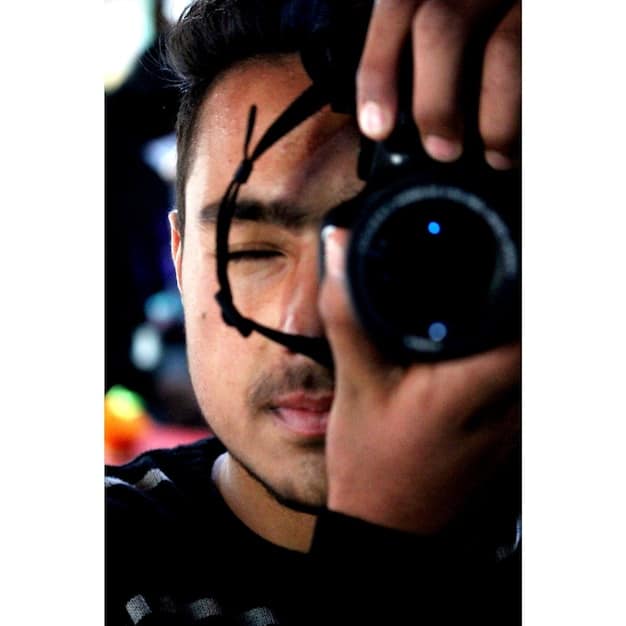
Hong Kyung-pyo’s work in “Parasite” demonstrates how critical cinematography is to narrative depth, especially in conveying abstract concepts like class struggle. The visual language is so powerful that it almost communicates the story independently of dialogue, a testament to the artistry and technical skill involved, influencing visual storytelling across Korean media, including K-dramas.
Case Study 3: “Crash Landing on You”
“Crash Landing on You” became a global phenomenon, not just for its heartwarming romance and compelling plot, but also for its stunning cinematography that transported viewers between the contrasting worlds of South and North Korea, as well as the picturesque landscapes of Switzerland. The series’ visual storytelling played a pivotal role in amplifying the emotional resonance of its star-crossed lovers’ journey.
The drama masterfully uses visual contrasts to differentiate environments. South Korea is often depicted with vibrant, bustling cityscapes, characterized by bright lights and dynamic camera movements that reflect its modern, fast-paced society. North Korea, in contrast, is frequently shown with more muted tones, traditional settings, and often static, contemplative shots that evoke a sense of timelessness or isolation, yet also natural beauty and community.
Contrasting Worlds Through Visuals
The cinematographers, led by Lee Myung-woo, meticulously crafted these visual distinctions to enhance the narrative’s central theme of division and connection. The use of natural light in North Korean scenes often gives a warmer, more rustic feel, emphasizing the innocence and simplicity of life there, despite its hardships. Swiss landscapes are rendered with breathtaking wide shots and sweeping drone footage, underscoring the fairy-tale aspect of the main characters’ destiny.
- Green and Earth Tones: Predominate in North Korean countryside scenes, symbolizing nature and tradition.
- Vibrant Cityscapes: Depict South Korea with bright, artificial lights, representing modernity and urban life.
- Expansive Aerial Shots: Capture the majestic beauty of Switzerland, offering a sense of escape and destiny.
- Intimate Close-ups: Emphasize tender moments between the protagonists, highlighting their emotional connection despite geopolitical barriers.
The cinematography in “Crash Landing on You” acts as a powerful narrative device, not merely as a backdrop. It visually communicates the chasm between two worlds, the emotional journey of characters crossing those boundaries, and the universal appeal of love blooming in unexpected places. The visual diversity and thoughtful execution contribute immensely to the drama’s widespread appeal and critical success, making it a benchmark in K-Drama cinematography.
Evolving Trends in K-Drama Cinematography
The landscape of K-drama cinematography is constantly evolving, driven by technological advancements, global influences, and the increasing demand for high-quality visual content. Modern K-dramas are increasingly experimenting with innovative techniques, pushing boundaries to create more immersive and visually arresting experiences for audiences worldwide.
One notable trend is the embrace of increasingly sophisticated VFX (visual effects) and CGI (computer-generated imagery). While traditionally used in fantasy or historical genres, VFX is now integrated into contemporary dramas to create visually stunning sequences, from subtle enhancements to elaborate fantastical elements. This allows directors more creative freedom in world-building and narrative execution.
Future Directions and Innovations
The rise of streaming platforms has also played a crucial role in promoting cinematic quality. With larger budgets and a global audience, K-dramas are increasingly adopting film-level production values, including the use of high-end cameras, specialized lenses, and extensive post-production processes. This commitment to visual excellence ensures that K-dramas remain competitive and captivating on the international stage.
- Virtual Production: Utilizing LED screens for backgrounds allows for realistic environments without extensive location shooting.
- Single-Take Sequences: Employed to create heightened tension or immerse viewers directly into a character’s experience.
- Aesthetic Blending: Incorporating elements from different film genres, such as neo-noir or fantastical realism, to create unique visual styles.
- Interactive Cinematography: Exploring ways to engage viewers more actively through visual cues or dynamic camera framing that responds to narrative beats.
Ultimately, the continuous innovation in K-Drama cinematography is a testament to the industry’s dedication to storytelling. By constantly refining their visual language, K-drama creators are not just telling stories; they are crafting experiences that resonate deeply with audiences, transcending cultural and linguistic barriers and solidifying their place as a global entertainment powerhouse.
| Key Aspect | Brief Description |
|---|---|
| 🎬 Composition & Framing | Meticulous arrangement of visual elements to guide viewer focus and convey narrative. |
| 💡 Lighting & Color Theory | Deliberate use of light and color palettes to set mood, convey emotion, and differentiate settings. |
| 🎥 Camera Movement & Editing | Dynamic or static camera work and post-production cuts pace the narrative and enhance emotional impact. |
| 🌍 World-Building Focus | Cinematography explicitly builds and contrasts worlds, as seen in “Goblin” and “Crash Landing on You.” |
Frequently Asked Questions About K-Drama Cinematography
K-drama cinematography is often called “cinematic” due to its film-like visual quality. This includes high production values, meticulous attention to composition, sophisticated lighting, dynamic camera movements, and extensive post-production color grading, which visually elevates the storytelling far beyond typical television series.
Color grading significantly influences the mood in K-dramas by establishing a visual tone for the entire series. Warm tones often convey romance or comfort, while cool tones might suggest melancholy or tension. This deliberate choice of palette reinforces emotional states, narrative arcs, and even character development throughout the show.
Slow motion is frequently used in K-dramas to heighten the emotional impact of key moments. By elongating time, it allows viewers to fully absorb characters’ expressions, nuanced reactions, and the significance of a particular event, making the scene more dramatic and memorable, thus enhancing empathy and emotional connection.
Reflections often serve as powerful symbolic elements in K-drama cinematography. They can indicate a character’s internal conflict, duality, or even reveal hidden truths. Using mirrors, windows, or water surfaces adds visual depth and layers of meaning, inviting viewers to delve deeper into the narrative’s psychological aspects and themes.
Natural landscapes in K-dramas are often more than just backdrops; they are integral to storytelling. They can evoke specific moods, symbolize freedom or confinement, or provide visual contrast between characters’ inner states and external environments. Majestic scenery, like Switzerland in “Crash Landing on You,” enhances the epic scale and romanticism of the narrative.
Conclusion
The intricate world of K-Drama cinematography is a testament to the power of visual storytelling. Through meticulous composition, thoughtful lighting, expressive color grading, and dynamic camera work, directors and cinematographers craft narratives that are not only seen but deeply felt. Works like “Goblin,” “Parasite” (as an influential film), and “Crash Landing on You” exemplify how these techniques transform simple plots into cinematic masterpieces, leaving an indelible mark on global entertainment. As the industry continues to evolve, the visual artistry of K-dramas promises to remain at the forefront, continually captivating audiences with its beauty and innovation.
